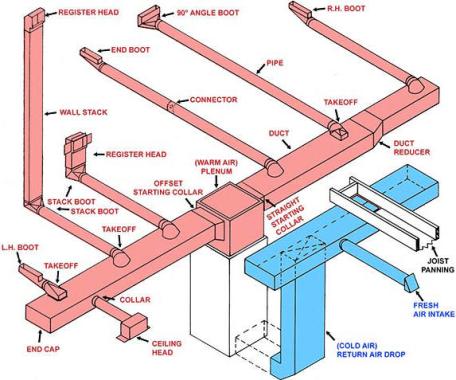McChensey Showroom Hours
Mon. - Fri. 10 a.m. - 5 p.m.
Serving All Major Brands of Heating & Cooling Equipment
SALES | SERVICE | INSTALLATION | BONDED | INSURED
Over 30 Years Experience
24 Hour Emergency Service

Duct Work
Ductwork
Ductwork
Understanding Basic Residential Ductwork Design
The purpose of Residential Ductwork Design is to properly distribute the airflow, produced by your heating/cooling system, to your house. This involves Return Air (unconditioned) coming into the heating/cooling system. Then, by heating/cooling that air, delivering the newly conditioned air to your home. An improperly designed ductwork systems can cost money through inefficiencies, and in some cases, cause premature failure of heating and cooling equipment. This means that your home's ductwork system is just as important as the equipment used to heat and cool your home.
The 3 Most Important Things to Understand About Residential Ductwork Designs are:
Furnaces and air conditioners require a certain amount of airflow, measured in CFM (Cubic Feet Per Minute), to be passed through the equipment (supply and return ducts) in order for the equipment to function properly and efficiently.
All homes have unique requirements and construction that pose obstacles when designing the ductwork system to accommodate each room with proper airflow. (This is especially true with older homes.)
The Ideal Ductwork System achieves both goals by providing enough airflow to and from the heating/cooling equipment as well as the home. For maximum efficiency, this "ideal" system should also be sealed at all seams with aluminum tape, and should be properly insulated when exposed to unconditioned environments (i.e. crawl spaces and attics).

The 3 Most Important Things to Understand About Residential Ductwork Designs are:
Furnaces and air conditioners require a certain amount of airflow, measured in CFM (Cubic Feet Per Minute), to be passed through the equipment (supply and return ducts) in order for the equipment to function properly and efficiently.
All homes have unique requirements and construction that pose obstacles when designing the ductwork system to accommodate each room with proper airflow. (This is especially true with older homes.)
The Ideal Ductwork System achieves both goals by providing enough airflow to and from the heating/cooling equipment as well as the home. For maximum efficiency, this "ideal" system should also be sealed at all seams with aluminum tape, and should be properly insulated when exposed to unconditioned environments (i.e. crawl spaces and attics).
Parts We Offer
Plenums
Return Air Drops
Ductwork
Ductwork Fittings
Pipe
Elbow
Tees
Takeoffs
Perimeter Boots
Ceiling Boots
Register
Frames
Cleats
Hangers
Panning
Dampets
Reducers
Saddles
Fresh Air Intake
Oval Pipe

24 Hour Emergency Service
McChesney Heating and Air Conditioning, Inc.421 Jefferson Blvd.Big Lake, MN 55309
© 2024
McChesney Heating and Air Conditioning, Inc.
All Rights Reserved | Privacy Policy
Yeahbay, Inc. | Online Business Visibility Simplified